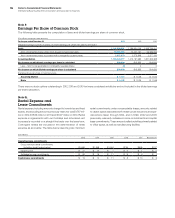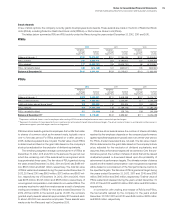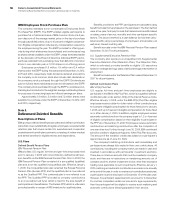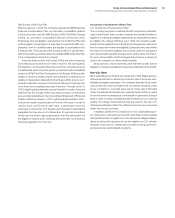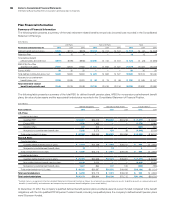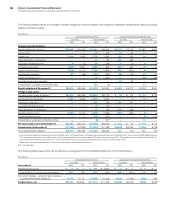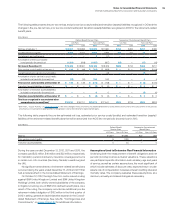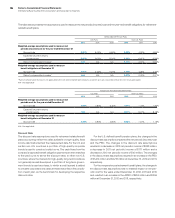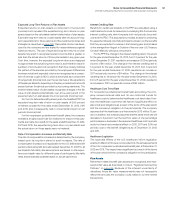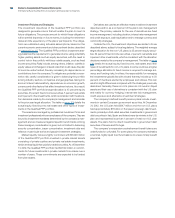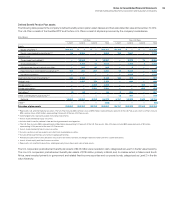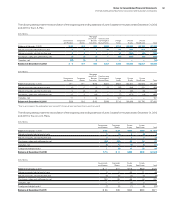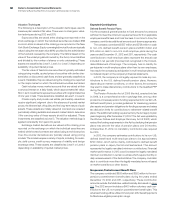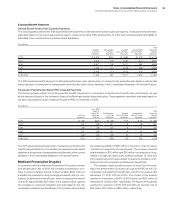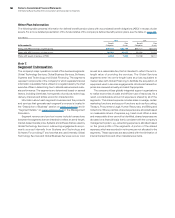IBM 2012 Annual Report Download - page 127
Download and view the complete annual report
Please find page 127 of the 2012 IBM annual report below. You can navigate through the pages in the report by either clicking on the pages listed below, or by using the keyword search tool below to find specific information within the annual report.
126 Notes to Consolidated Financial Statements
International Business Machines Corporation and Subsidiary Companies
126
The table below presents the assumptions used to measure the net periodic (income)/cost and the year-end benefit obligations for retirement-
related benefit plans.
Defined Benefit Pension Plans
U.S. Plans Non-U.S. Plans
2012 2011 2010 2012 2011 2010
Weighted-average assumptions used to measure net
periodic (income)/cost for the year ended December 31
Discount rate 4.20% 5.00% 5.60% 4.28% 4.33% 4.84%
Expected long-term returns
on plan assets 8.00% 8.00% 8.00% 6.26% 6.41% 6.56%
Rate of compensation increase* N/A N/A N/A 2.43% 2.37% 2.92%
Weighted-average assumptions used to measure
benefit obligations at December 31
Discount rate 3.60% 4.20% 5.00% 3.23% 4.28% 4.33%
Rate of compensation increase* N/A N/A N/A 2.51% 2.43% 2.37%
* Rate of compensation increase is not applicable to the U.S. defined benefit pension plans as benefit accruals ceased December 31, 2007 for all participants.
N/A—Not applicable
Nonpension Postretirement Benefit Plans
U.S. Plan Non-U.S. Plans
2012 2011 2010 2012 2011 2010
Weighted-average assumptions used to measure net
periodic cost for the year ended December 31
Discount rate 3.90% 4.80% 5.40% 7.37% 7.75% 7.92%
Expected long-term returns
on plan assets N/A N/A N/A 9.01% 9.07% 9.16%
Weighted-average assumptions used to measure
benefit obligations at December 31
Discount rate 3.30% 3.90% 4.80% 6.43% 7.37% 7.75%
N/A—Not applicable
Discount Rate
The discount rate assumptions used for retirement-related benefit
plans accounting reflect the yields available on high-quality, fixed
income debt instruments at the measurement date. For the U.S. and
certain non-U.S. countries, a portfolio of high-quality corporate
bonds is used to construct a yield curve. The cash flows from the
company’s expected benefit obligation payments are then matched
to the yield curve to derive the discount rates. In other non-U.S.
countries, where the markets for high-quality long-term bonds are
not generally as well developed, a portfolio of long-term govern-
ment bonds is used as a base, to which a credit spread is added
to simulate corporate bond yields at these maturities in the jurisdic-
tion of each plan, as the benchmark for developing the respective
discount rates.
For the U.S. defined benefit pension plans, the changes in the
discount rate assumptions impacted the net periodic (income)/cost
and the PBO. The changes in the discount rate assumptions
resulted in a decrease in 2012 net periodic income of $258 million,
a decrease in 2011 net periodic income of $171 million and a
decrease in 2010 net periodic income of $40 million. The changes
in the discount rate assumptions resulted in an increase in the PBO
of $3,414 million and $4,216 million at December 31, 2012 and 2011,
respectively.
For the nonpension postretirement benefit plans, the changes in
the discount rate assumptions had no material impact on net peri-
odic cost for the years ended December 31, 2012, 2011 and 2010
and resulted in an increase in the APBO of $252 million and $359
million at December 31, 2012 and 2011, respectively.


